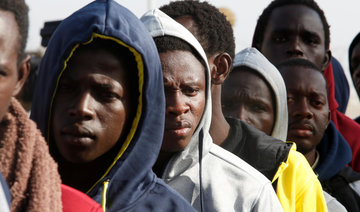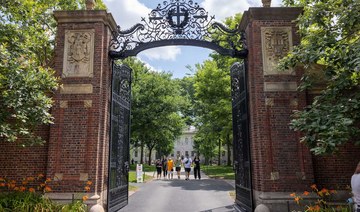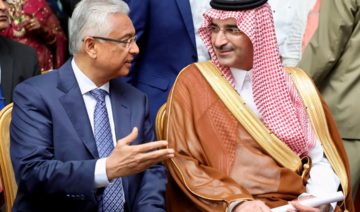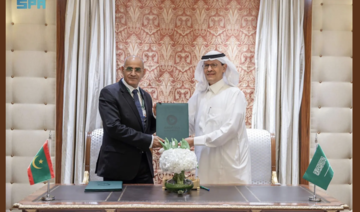DAKAR: Most African migrants suffer abuse, torture and rape as they cross lawless Libya in pursuit of a new life in Europe, Oxfam said on Wednesday as it urged Europe to offer safer routes.
The voyage from Libya across the Mediterranean Sea to Italy — often on flimsy boats run by people smugglers — is the main route to Europe for migrants from Africa, with more than 95,000 people having set sail this year, and 180,000 in 2016.
Before they even embark on the perilous sea leg of their voyage, many migrants end up detained in Libya, and face abuse, extortion, and forced labor at the hands of armed groups, criminal gangs and smugglers, aid agencies say.
Migrants who made it to Italy told Oxfam how they were kept in cells full of dead bodies, forced to call their families to demand ransom money, and beaten and starved for months on end.
Three-quarters of the 160-odd arrivals interviewed by the charity saw a fellow migrant tortured or killed, while at least eight in 10 said they suffered “inhuman or degrading treatment.”
“These are people who are escaping war, persecution and — and yet in Libya they encounter another hell,” Roberto Barbieri, head of Oxfam Italy, said in a statement.
Several African migrants who were once detained in Libya have told the Thomson Reuters Foundation of the “hell” they endured — beaten, raped and watching others die.
All but one of the 31 women migrants who spoke to Oxfam said they had faced sexual violence in Libya. Esther, a 28-year-old from Nigeria, told the charity she had suffered a miscarriage after regular beatings during her five months in detention.
“I lost my poor little child who was in my womb due to the beatings... and my sister died from the beatings and abuse. I lost a lot of blood without receiving any help,” she said.
Many women migrants take birth control such as contraceptive injections before leaving home as they fear rape and falling pregnant along the journey, activists say.
Oxfam urged European nations to stop pursuing migration policies that prevent people leaving Libya by sea, which the charity said puts migrants at risk of abuse and exploitation.
“People must come first,” said Barbieri of Oxfam. “The EU should provide safe routes for people to come to Europe and have access to a fair and transparent processes for claiming asylum.”
Most African migrants crossing Libya fall prey to abuse: Oxfam
Most African migrants crossing Libya fall prey to abuse: Oxfam

Future of relations between Japan and Middle East in the spotlight at event in Amman

- Topics at conference include economic and regional integration, formulation of security policies
- Experts, decision-makers discuss the challenges extremism pose to Japanese interests in the region
AMMAN: Delegates at the inaugural Japan-Middle East Strategic Dialogue Conference, which concluded on Monday in Amman, discussed the future of Japan’s relations with countries in the region.
Specific topics covered during the two-day event, which was organized by the Center for Strategic Studies at the University of Jordan and the Research Center for Advanced Science and Technology at the University of Tokyo, included economic and regional integration, the development and transfer of technology, and the formulation of security policies, the Jordan Times reported.
The participants included experts and decision-makers from across the Middle East and Japan, who discussed the challenges extremism and terrorism pose to Japanese interests in the Middle East, and the significant effects they have on the behavior of non-state actors and regional stability.
They also highlighted notable investments by Japan in the burgeoning entrepreneurship sector in the Middle East, particularly in small and medium enterprises, and the nation’s promising ventures in the development of energy infrastructure in the region.
During the opening ceremony on Sunday, Nazir Obeidat, president of the University of Jordan, said the conference can play a significant role as a cornerstone of Jordanian-Japanese relations, which have been characterized over the years by mutual respect and stability.
He highlighted the exceptional nature of a bilateral relationship he said is underpinned by a shared philosophy, its diverse components, and effective mechanisms for the implementation of agreements. He also underscored Jordan’s growing belief in the pivotal role that education, research, innovation and creativity can play in fostering genuine development, economic prosperity and sustainability.
Obeidat expressed his hope that Japan can help Jordan foster an environment conducive to scientific advancement and the building of partnerships between academia and industry, and affirmed his university’s commitment to this.
The Japanese ambassador to Jordan, Okuyama Jiro, noted that this year marks the 70th anniversary of Jordanian-Japanese diplomatic relations, and the 50th anniversary of the establishment of the Japan International Cooperation Agency office in Jordan.
He reiterated that Japan views Jordan as a strategic ally, in recognition of the nation’s pivotal role as a regional hub and gateway to the Middle East, with significant ties to Africa.
The envoy also acknowledged Jordan’s resilience in its efforts to confront economic challenges and refugee crises while maintaining security and stability, and praised authorities in the country for their exemplary approach to addressing multifaceted issues.
Gulf Creatives Conference goes ahead despite nearby protest encampment

- Conference included 24 discussion sessions and five workshops covering topics such as public policy, innovation strategies, and the future of healthcare
- KFSH&RC CEO Dr. Majid Ibrahim Al-Fayyadh spoke of the emergence of a leading healthcare sector in the region after a decades-long transformation plan
CAMBRIDGE: The second edition of the Gulf Creatives Conference took place at Harvard University at the weekend, despite pro-Palestine protests on the campus.
“Amid the rising tensions on US college campuses, we believe firmly in the power of creativity and the arts in healing wounds and bridging divides,” Abdulla Almarzooqi, chairperson of the organization’s UAE Committee and a graduate student at Harvard, told Arab News in an interview.
The event attracted over 1,000 attendees and more than 170 speakers, among whom was Gulf Co-operation Council Secretary-General Jasem Al-Budaiwi. He took to the stage to address Gulf students and outline the region’s vision to lessen reliance on oil revenues by embracing diverse sectoral reforms.
“The strategic location, coupled with robust infrastructure, paves the way for the council member states to attract international partnerships that support their long-term development goals,” Al-Budaiwi said.
He added: “This dynamic approach is vital for sustaining economic growth and ensuring the resilience of Gulf economies in the face of global economic fluctuations and regional challenges.”
He also praised students for hosting such an event at one of the world’s most prestigious universities.
The conference included 24 discussion sessions and five workshops covering topics such as public policy, innovation strategies, and the future of healthcare.
Among the main speakers on healthcare was Dr. Majid Ibrahim Al-Fayyadh, CEO of the King Faisal Specialist Hospital and Research Center, who spoke of the emergence of a leading healthcare sector in the region after a decades-long transformation plan.
“The Saudi leadership has a clear vision for KFSH&RC, which was crowned by royal order to transform it into an independent institution of a private, nonprofit nature,” he said.
The transformation includes enhancing existing services and exploring new medical trends to improve health and well-being, he added.
Other panelists included Maryam Bin Theneya, second deputy speaker at the Federal National Council of the UAE, Bader Al-Attar of the Kuwait Petroleum Corporation, and Saudi Media Company’s Khalid Al-Khudair.
UAE, Mauritius sign MoU to boost energy cooperation

- Two sides will exchange expertise and information on emerging technologies, best practices and knowledge-sharing
DUBAI: The Emirati Ministry of Energy and Infrastructure and the Mauritian Ministry of Energy and Public Utilities inked a memorandum of understanding on Monday aimed at bolstering collaboration across water, energy and sanitation sectors, Emirates News Agency reported.
The agreement outlines a broad spectrum of cooperation, encompassing energy, renewable energy, hydrogen and its derivatives, energy efficiency, liquefied natural gas and water management.
Also under the agreement, cooperation will also take place in the water efficiency, desalination, digital technology applications, wastewater treatment and sanitation sectors.
Under the MoU, the two sides will exchange expertise and information on emerging technologies, best practices and knowledge-sharing.
They will also explore joint research and development initiatives and implement projects using public-private partnership and independent power producer models.
The agreement also facilitates joint visits, meetings and technical workshops, while encouraging bilateral investment in relevant sectors.
“This MoU cements the longstanding relations between the UAE and Mauritius and serves their shared commitment to sustainable development and environmental protection. The UAE follows a collaborative approach to meet the targets of the UAE Energy Strategy 2050, the National Hydrogen Strategy 2050, and the UAE Water Security Strategy 2036, which collectively contribute to the UAE’s net zero by 2050 target,” said Suhail bin Mohammed Al-Mazrouei, Emirati minister of energy and infrastructure.
Georges Pierre Lesjongard, Mauritian minister of energy and public utilities, thanked the UAE for the longstanding collaboration between the the emirates and Mauritius in various sectors.
He said that the cooperation played a pivotal role in advancing Mauritius’s goals outlined in its nationally determined contributions and in enhancing resilience against the impacts of climate change, particularly for Mauritius as a small island developing state.
Doctors treat Sharjah school teacher with rare nerve disease

DUBAI: Doctors in a Sharjah hospital helped a 46-year-old resident undergo treatment for a debilitating nerve disease that prevented her from walking.
Annie Cherian, a school teacher from India and living in Sharjah, experienced weakness in her limbs six months ago and her condition quickly worsened, making daily life tasks like brushing her hair or even walking increasingly difficult.
On April 3 Cherian sought help from doctors at Aster Hospitals in Sharjah and within two days received a CIDP diagnosis, a condition that affects approximately 1-2 people in 100,000 annually according to the CIDP Foundation International.
CIDP, or Chronic Inflammatory Demyelinating Polyneuropathy, is a rare autoimmune nerve disease that attacks the covering of the nerve cells and leads to loss of physical strength and sensation in the arms and legs. It can be caused by a virus or infection that enters the body.
Usually CIDP is treated with steroids, but as Cherian is also a diabetic, this option was not viable as it might worsen her diabetes, explained Dr. Rajesh Chaudhary, specialist neurologist at Aster Hospital Sharjah.
With the help of Chaudhary and his medical team, Cherian underwent an intravenous treatment which lasted five days.
The treatment involved introducing antibodies through the vein, which helps existing antibodies in the body to strengthen and fight off infections and diseases, Chaudhary explained.
“Without proper treatment, a patient’s quality of life becomes very poor and they struggle to do mundane everyday tasks,” said Chaudhary.
Other symptoms of CIDP include problems walking, lack of strength, tingling and pain in the limbs, he said.
Cherian responded well to the treatment and regained strength in her limbs, and is now able to perform everyday tasks unassisted.
Chaudhary said Cherian is expected to lead a normal life after the treatment and will most likely not experience weakness or fatigue in her limbs again.
“I am so grateful for the medical team who helped me recover remarkably and restore my strength, but also made me aware of autoimmune disease’s impact and the importance of timely medical intervention,” said Cherian.
Israeli forces push into Gaza from north and south

- Some of the most intense fighting for weeks now taking place on both the northern and southern edges of Gaza
- Hundreds of thousands of Palestinians again take flight and aid groups warn humanitarian crisis could worsen
CAIRO: Israeli forces pushed deep into the ruins of Gaza’s northern edge on Monday to recapture an area where they had claimed to have defeated Hamas months ago, while at the opposite end of the enclave tanks and troops pushed across a highway into Rafah.
With some of the most intense fighting for weeks now taking place on both the northern and southern edges of Gaza, hundreds of thousands of Palestinians have again taken flight, and aid groups warn that a humanitarian crisis could sharply worsen.
Israel described its latest return to the north, where it pulled out most of its troops five months ago, as part of a “mop-up” stage of the war to prevent fighters from returning, and said such operations had always been part of its plan. Palestinians say the need to keep fighting amid the ruins of previous battles is proof Israel’s military objectives are unattainable.
In sprawling Jabalia, the biggest of Gaza’s eight camps built 75 years ago to house Palestinian refugees from what is now Israel, tanks pushed toward the heart of the district. Residents said tank shells were landing at the center of the camp and air strikes had destroyed clusters of houses.
Thick clouds of black smoke from explosions could be seen rising over northern Gaza from the Israeli border on Sunday.
Israeli troops are seeking to wipe out Hamas, which has said it is committed to Israel’s destruction. The militant group burst into Israel on Oct. 7, killing 1,200 and taking more than 250 hostages, by Israeli tallies.
The Palestinian death toll in the war has now surpassed 35,000, according to Gaza health officials who fear many more bodies are lost under the rubble. The fighting has laid waste to the coastal enclave and caused a deep humanitarian crisis, with the Gaza health ministry warning in a statement on Monday that the medical system is on the verge of collapse due to a shortage of fuel to power generators and ambulances.
Palestinian health officials on Monday said they had so far recovered 20 bodies of Palestinians killed in the overnight air strikes on Jabalia, while dozens were injured.
At the opposite end of Gaza in Rafah, against the border fence with Egypt, Israel stepped up aerial and ground bombardments on the eastern areas of the city, killing people in an air strike on a house in the Brazil neighborhood.
Israel ordered residents out of the east of the city last week, and extended that order to central areas in recent days, sending hundreds of thousands of people, most of whom are already displaced, fleeing for new shelters.
Residents said Israeli air and ground bombardments were intensifying and tanks had cut off the main north-south Salahuddin Road that divides the eastern part of the city from the central area.
“The tanks cut the Saladuddin road east of the city, the forces are now in the southeast side, building up near the built-up area, the situation is dreadful and the sounds of explosions never stopped,” said Bassam, 57, from the Shaboura neighborhood in Rafah.
“People continue to leave Rafah, even far away near the western areas as no place looks safe now and also because people do not want to escape at the last minute should tanks make sudden incursions and moving out becomes too late,” he told Reuters via a chat app.
UNRWA, the main United Nations aid agency in Gaza, estimated that about 360,000 people had fled the southern city since the Israeli military gave its first evacuation order a week ago.
BOMB SHIPMENT ON HOLD
The assault on Rafah has caused one of the biggest splits in generations between Israel and its main ally the United States, which put some deliveries of weapons on hold for the first time since the war began. Washington has said Israel must not assault Rafah without a plan in place to protect civilians there, which it has yet to see.
Jack Lew, the US ambassador to Israel, signalled on Sunday that the Rafah incursion was still on a scale that Washington considers acceptable.
“The president was clear in the interview he gave the other evening that what Israel has done so far hasn’t crossed over into the area where our disagreements lie,” Lew told Israel’s Channel 12 TV, without elaborating on what that area entails.
“I’m hoping we don’t end up with real disagreement.”




















